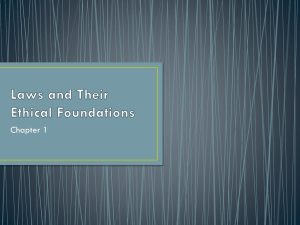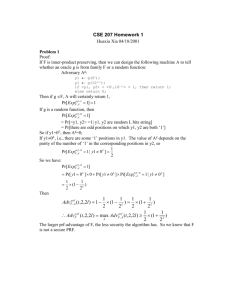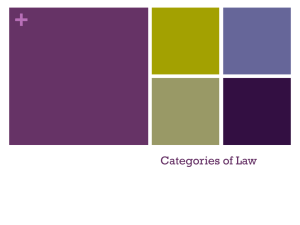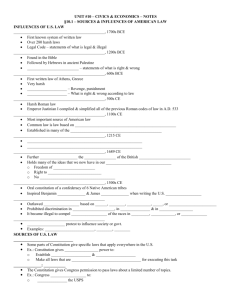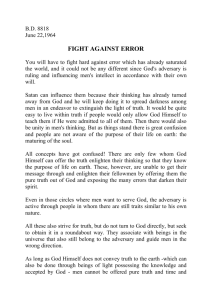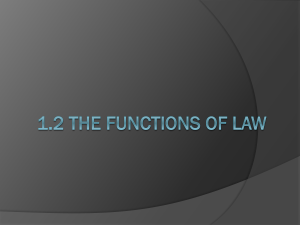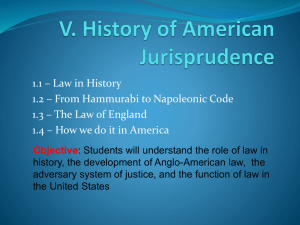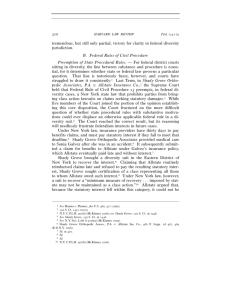The Fundamental Principles of Civil Procedure
advertisement
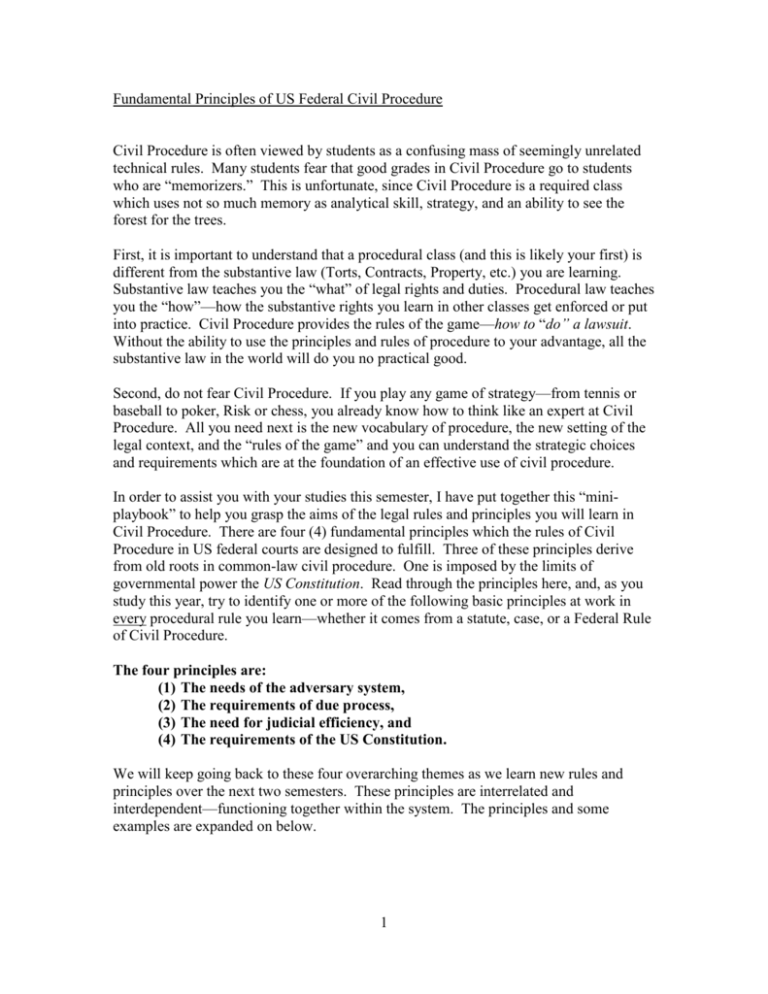
Fundamental Principles of US Federal Civil Procedure Civil Procedure is often viewed by students as a confusing mass of seemingly unrelated technical rules. Many students fear that good grades in Civil Procedure go to students who are “memorizers.” This is unfortunate, since Civil Procedure is a required class which uses not so much memory as analytical skill, strategy, and an ability to see the forest for the trees. First, it is important to understand that a procedural class (and this is likely your first) is different from the substantive law (Torts, Contracts, Property, etc.) you are learning. Substantive law teaches you the “what” of legal rights and duties. Procedural law teaches you the “how”—how the substantive rights you learn in other classes get enforced or put into practice. Civil Procedure provides the rules of the game—how to “do” a lawsuit. Without the ability to use the principles and rules of procedure to your advantage, all the substantive law in the world will do you no practical good. Second, do not fear Civil Procedure. If you play any game of strategy—from tennis or baseball to poker, Risk or chess, you already know how to think like an expert at Civil Procedure. All you need next is the new vocabulary of procedure, the new setting of the legal context, and the “rules of the game” and you can understand the strategic choices and requirements which are at the foundation of an effective use of civil procedure. In order to assist you with your studies this semester, I have put together this “miniplaybook” to help you grasp the aims of the legal rules and principles you will learn in Civil Procedure. There are four (4) fundamental principles which the rules of Civil Procedure in US federal courts are designed to fulfill. Three of these principles derive from old roots in common-law civil procedure. One is imposed by the limits of governmental power the US Constitution. Read through the principles here, and, as you study this year, try to identify one or more of the following basic principles at work in every procedural rule you learn—whether it comes from a statute, case, or a Federal Rule of Civil Procedure. The four principles are: (1) The needs of the adversary system, (2) The requirements of due process, (3) The need for judicial efficiency, and (4) The requirements of the US Constitution. We will keep going back to these four overarching themes as we learn new rules and principles over the next two semesters. These principles are interrelated and interdependent—functioning together within the system. The principles and some examples are expanded on below. 1 The needs of the adversary system The adversary system of justice is the heart of the common-law legal system. The adversary system requires the parties themselves (and their legal representatives) to drive and shape the legal dispute. The theory behind the adversary system is that the process of each side putting forth its best arguments and evidence, and the ability to cross-examine and test the opposing evidence is the best way to lead to the Truth (capital “T” intentional here) of the dispute. Thus, the opposing parties—or adversaries—are given great power in this system to determine the legal arguments and evidence to place before the court. Placing such power in the hands of the parties entails corresponding responsibilities to make the system work. For example, the principles that a plaintiff have must have standing and must obtain jurisdiction over the person of the defendant in order to proceed with the lawsuit are necessary to ensure that there are two opposing parties with a big enough stake in the outcome of the dispute to put forward the best possible evidence so as to arrive at that “Capital T” Truth. Analogously, the rules of discovery enable parties to gather information from others in order to obtain evidence for a trial. Thus, rules or principles which provide parties with either a power or an obligation in order to ensure the lawsuit can generate the “Truth” are rules supporting the adversary system. The requirements of due process Due process may be considered a key component of the adversary system, since it seeks to ensure basic fairness and a level playing field for the opposing litigants. Due process is often said to have two components—procedural and substantive due process. Procedural due process (referred to in much of the common-law world as “natural justice”) refers to notice and an opportunity to be heard in response. If one side did not have notice of what the other meant to do, as well as an opportunity to present opposing evidence and argument, the adversary system would lose one of its chief safeguards of reliability—an informed and interested party in the dispute. Rules such as the requirement of personal service of process to begin the lawsuit reflect procedural due process requirements by ensuring that the defendant has notice of the lawsuit. Similarly, the requirement that a litigant have an opportunity to respond to a motion (request for the court to make a ruling) brought by the opposing party allows an opportunity to present the other side of the case. Substantive due process is a term embracing notions of basic fairness and justice—some minimum level of fairness which the litigant must be allowed. The requirement that a defendant have certain “minimum contacts” with a forum state to be sued there reflects, in part, this substantive component of due process. Due process requirements can also overlap with Constitutional requirements through the due process clause of the 5th and 14th Amendments to the US Constitution. 2 The need for judicial efficiency There is a famous equitable maxim (principle for deciding cases) which states that “justice delayed is often justice denied”. In order that justice not be delayed so long that a remedy is effectively denied, and in order not to overburden the courts system, some rules promote more efficient (less costly or quicker) ways to resolve disputes. So, rules which have the purpose or effect of reducing court or litigant time or move the lawsuit along increase judicial efficiency. Rules such as those permitting class actions or joinder of claims and parties are designed to allow a court to hear a single complex suit rather than several smaller ones, thus avoiding unnecessary duplication. So-called “case management” rules giving judges the power to move cases forward if the parties are lax or to determine cases without the need for a trial (like summary judgment) also contribute to efficiency through faster resolution of disputes. However, efficiency concerns should not be allowed to override considerations of due process. Trials and procedures must be fair to the litigants for the adversary system to function. So, efficiency-based rules will always have a minimum due process requirement. Think of the prerequisites for substituted service here, which require that the method of service chosen is likely to bring the suit to a defendant’s actual notice. When you find a rule that increases efficiency, look for its corresponding due process “backstop”, “hurdle” or other minimum requirement. The requirements of the US Constitution The United States has a system of dual governance and provides that the central federal government has only those powers given to it under the US Constitution. US federal courts thus have limited powers which confine how they may operate properly within our governmental structure. So, those rules which limit the ability of federal courts to make decisions because of our Constitutional structure reflect this principle. As noted above, some due process requirements are Constitutional as well. The subject-matter jurisdiction rules are based on the limited powers of federal courts in our system, which can hear and determine only certain kinds of disputes as permitted by the US Constitution. Also, the choice of law rules represented by the Erie doctrine form part of the boundary of federal action required by the Constitution. Don’t worry if this seems too much to grasp just now—we will build on this all year. This is just a foretaste of how we will try to view the rules within the system. I look forward to discussing these principles with you more as we proceed through the class. K. Lee Adams Associate Professor, Atlanta’s John Marshall Law School 3

